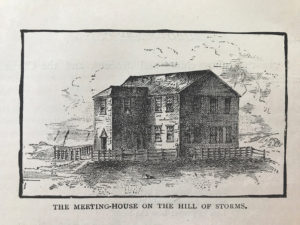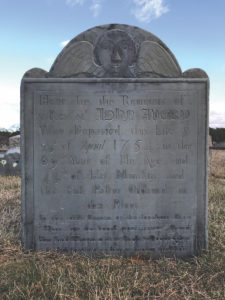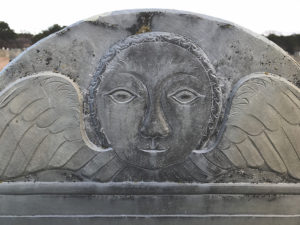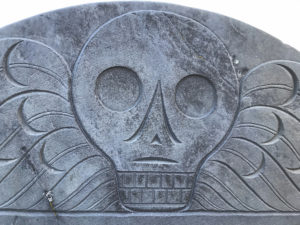TRURO — Everyone who drives to Provincetown along Route 6 in North Truro travels across one of the town’s highest elevations, called in the old custom the “Hill of Storms.” When you see Truro’s public safety facility on one side of the highway and the Old North Cemetery on the other, you know you’re there.
Familiarity with North Truro’s topography helps explain the old name. The steep elevations — what we know today as the Highlands, and what the early inhabitants knew by the indigenous name, Tashmuit — that slope from the Atlantic Ocean to Cape Cod Bay have been scoured by deep hollows where early Truro settlers built their homes to defend against the fearful winds. The Hill of Storms had no such defense, and yet there, on that bleak, windswept plain, a Congregational meetinghouse stood alone for 120 years — a beacon both spiritual and earthly, a gathering place for religious, civic, and political affairs. Before construction of the Highland Light, it served as another kind of beacon, a landmark seen by mariners far out at sea.
In 1709, the same year that Truro was incorporated as a town, the First Congregational Parish was founded. One tradition tells of the first meetinghouse being built at Pond Village, near or on the site of the current Christian Union Church on Shore Road.
Truro historian Shebnah Rich, while acknowledging the dearth of records relating to the first meetinghouse, offers a convincing case in his Truro — Cape Cod, or Land Marks and Sea Marks (1883) that the original meetinghouse was situated southwest of Tashmuit. Records show that in 1713 ground was cleared on the north side of the meetinghouse for a burying place, now the Old North Cemetery, whose earliest known grave is that of Mrs. Hannah Paine (1661-1713). Thus, the original church was most likely located on the Hill of Storms.

In 1720 the meetinghouse was replaced with a new structure, enlarged in 1765 and again in 1792. The “second” Congregational church served as Truro’s only house of worship until 1827, when a shifting economic and population center necessitated the building of the current “third” church at Truro Village. There it shared the “Hill of Churches” with the Methodist Church, built in 1826. The old meetinghouse on the Hill of Storms fell into disuse and was taken down in 1840.
Remarkably, the Hill of Storms meetinghouse embraced the entire township of Truro for 118 years — three and a half generations. Overseeing the progress of the parish over that entire time span were just three ministers, the Rev. John Avery, the Rev. Caleb Upham, and the Rev. Jude Damon, all Harvard graduates, all much esteemed by their congregations, and all buried in the Old North Cemetery in the very ground on which they preached, their graves marked by handsome colonial headstones.

John Avery was born Feb. 4 in either 1684 or 1685 in Dedham to Robert Avery and Elizabeth Lane. Having spent time ministering to the residents of Truro as early as 1709, he was formally invited to settle among them and was ordained on Nov. 1, 1711 as the town’s first pastor.
Between 1711 and 1729, 10 children were born in Truro to Avery and his first wife, Ruth Little, the daughter of Ephraim Little and Mary Sturtevant and the great-granddaughter of Mayflower passenger Richard Warren. After her death in 1732, Avery married Ruth Knowles, also of Pilgrim stock, the great-great-granddaughter of Elder William Brewster. Rev. Avery married for a third time in 1745 to the widow Mary Rotch.
From a congregation that began with seven members as an offshoot of the first Eastham Congregational church (Cove Burying Ground), Rev. Avery, who also served as Truro’s physician, grew his church membership by 367 members over a 44-year pastorate. When he died on April 23, 1754, he was remembered as a minister “greatly beloved and admired by his people, being a good and useful preacher of an exemplary life and conversation. As physician he was no less esteemed. He always manifested great tenderness for the sick, and his people very seriously felt their loss in his death.”

In October 1755, after a period of “probation” ministering to the Truro faithful, Caleb Upham was ordained the town’s second minister. Born in Malden on Oct, 17, 1723, he was the son of Ebenezer Upham and Elizabeth Blanchard and could trace his ancestry to his great-great-grandfather, John Upham, who arrived in Weymouth from Devon, England in 1635 during the Great Migration. Before settling in Truro, Caleb taught school and preached in Falmouth, Maine. There, in May 1755, he married Priscilla Allen, the daughter of the Rev. Benjamin Allen. Their only child, Benjamin Allen Upham, was born in February 1756.
Upham’s 31-year ministry included the entire period of the Revolutionary War, in which his son served. Shebnah Rich noted that “Mr. Upham was a stanch and uncompromising Patriot. He entered bravely upon the work of sustaining the colonies, greatly encouraged his people in public and in private, sympathized with them in their great losses, sufferings, and struggles, and, as we have seen by the records, was associated with the citizens in the most important committees.” He died on April 10, 1786. Priscilla, his “amiable and pious consort,” had died a year earlier.

He was succeeded by the Rev. Jude Damon, ordained on Nov. 15, 1786. Born in Sudbury on Sept. 23, 1751, he was the son of Thomas Damon and Elizabeth Stow. Both his father and grandfather were veterans of the Revolution. In February 1792, Damon married Elizabeth Lewis of Truro. The couple had four sons, including twins John and Josiah, born in 1797. Josiah died from croup in 1800, just days before his third birthday, and is also buried in Old North Cemetery.
Rev. Damon’s ministry, the last year of which he preached in the new meetinghouse in Truro Village, ended after 42 years with his death in November 1828. “He possessed a kind, peaceful disposition,” wrote Shebnah Rich. “There was little occasion for a lawyer where he gathered his flock.” Indeed, his headstone is inscribed with the words: “Blessed are the peacemakers; For they shall be called the children of God.”
In 1839, while preparing his Historical Collections, engraver and historian John Warner Barber visited Truro, copied the inscription from the grave of John Avery, and made a small drawing of the “Ancient Church in Truro” about which he invoked Macpherson’s Poems of Ossian:
“The dark brown years” have passed over it. It stands alone, and on the hill of storms! It is seen afar by the mariner as he passes by on the dark rolling wave.
One wonders how many, over those years, were comforted by its presence and by the words of its ministers.



